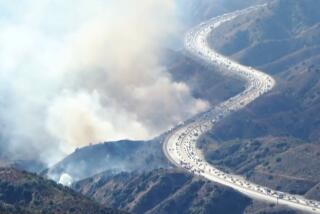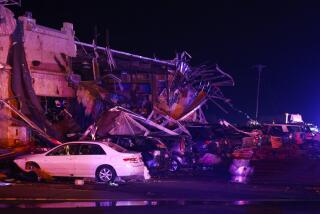Some Oklahoma wildfires, made worse by drought, now under control
Firefighting crews battled triple-digit heat, dry winds and multiple wildfires Saturday that scorched dozens of homes and miles of dry grassland near Oklahoma City and Tulsa, officials said. Some of the fires, but not all, were under control Saturday.
Columns of smoke blackened the sky and threatened grasslands that have become tinder in the most severe drought the United States has seen since 1956. Hundreds of people in four counties evacuated Friday. Authorities closed two state highways and parts of Interstate 44 – the freeway that cuts between Oklahoma City and Tulsa – for several hours Friday night.
Oklahoma Gov. Mary Fallin toured Luther, Okla., a small town north of Oklahoma City, on Saturday morning, calling the fire and its damage “heartbreaking.”
Photos: Drought in the Midwest
Officials estimate 47 homes and other buildings were damaged in the flames near Luther, where about 4 square miles were burned.
About 40 more buildings and 78 square miles were destroyed in a fire in Mannford, near Tulsa, that was not under control Saturday afternoon. And another fire that started near Noble, Okla., and moved south toward the University of Oklahoma in Norman destroyed at least 25 buildings, some of them homes.
The fire near Luther was started by an arsonist, the Oklahoma County Sheriff’s Department said. Deputies searched Saturday for a man in a black Ford F150 pickup who witnesses said set a newspaper on fire and tossed it out his window into a field, Sheriff’s Department spokesman Mark Myers told the Los Angeles Times.
“The fire is out,” Myers said. “Now we have to find him.”
Officials have said this could be the worst fire season in Oklahoma history.
Drought conditions that have stretched on in Oklahoma for months worsened the effects of the fire, Myers said. In bone-dry months, sparse vegetation became tinder. Central Oklahoma usually gets four times as much rain in July as they did this year, according to the Oklahoma Climatological Survey.
The temperature in Luther hovered at 113 degrees Friday when the fire reportedly started about 4 p.m. Firefighters took frequent breaks from the front lines of the fire, where temperatures were even higher, said Forrest Mitchell, a spokesman for the National Weather Service in Noble, in an interview with The Times.
“It was basically like standing in front of a blowdryer while you’re trying to do your job,” Myers said. “Everyone is exhausted.”
Relief, of sorts, is on the way. The temperature Saturday was not expected to rise much above 100 degrees.
“After you’re at 113 degrees, that’s quite a drop,” Mitchell said.
The NWS office is about 15 miles from the fire. The meteorologists there couldn’t see the flames, but they could see – and taste – the khaki columns of smoke rising from the fields.
ALSO:
Colorado shootings: University launches independent review
Mars landing: Do-or-die time for Curiosity rover; it’s on its own
Reminder to U.S. Senate: All those commemorations come with costs
Join Laura on Google+ and Twitter @laura_nelson. Email: laura.nelson@latimes.com
More to Read
Sign up for Essential California
The most important California stories and recommendations in your inbox every morning.
You may occasionally receive promotional content from the Los Angeles Times.











